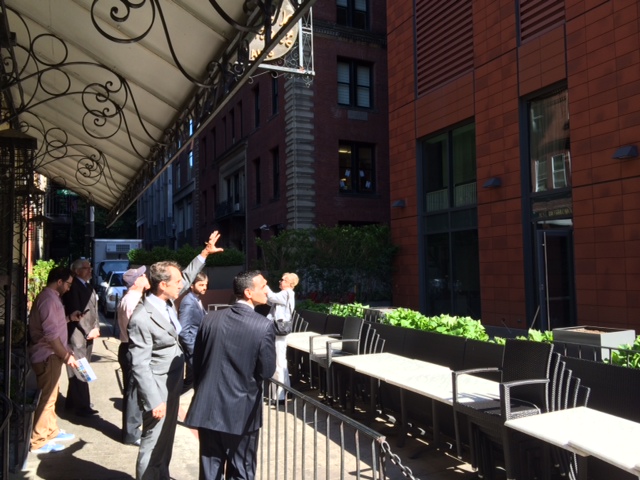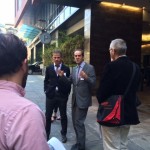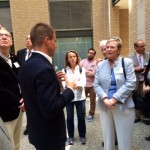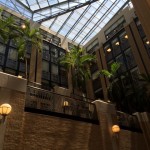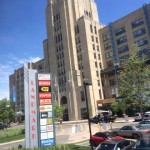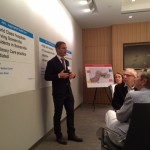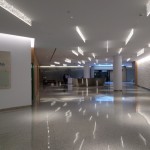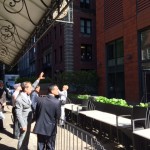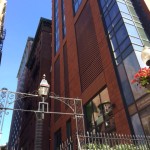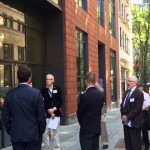The Union Square Due Diligence team conducted its final tour on Wednesday, June 11, with local development team The Abbey Group. The original 10-person delegation (short two of its members) was joined by three other members of the SRA: James F. McCarthy, Iwona Bonney and William Gage. Together, this group saw development projects in Downtown Crossing and The Fenway.
The Abbey Group showed us two of its projects that effectively bookend Downtown Crossing: 45 Province and Lafayette City Center. Each was impressive in its own right, but for different reasons.
45 Province drew attention for its design and architecture. The 137-unit residential tower is nearly brand new, but was designed to blend into the existing neighborhood that has several historic buildings (including the former Boston City Hall). From the street, it’s hard to tell the height of the building, and the upper-story levelers were designed so as to not create any shadows on historically significant buildings nearby. Though the building does not include any affordable housing units, the Abbey Group gave the City of Boston what would have been the equivalent cost of the affordable units, plus 50% of the profit from what those units actually sold for at market rate—the equivalent of $7 million, much more significant than the City would have garnered under the traditional affordable housing requirement.
Lafayette City Center, meanwhile, was redeveloped and redesigned in order to draw technology companies to Downtown Crossing. During a period when many companies fled Downtown Crossing, the Abbey Group invested in the area. The Abbey Group invested $5 million alone in the renovation of the lobby, which includes a lounge area that draws people into the public space of the six-story, 61,000 sq. ft. office and retail complex. In many ways, the departure of State Street Corporation, which is moving from Lafayette City Center to the Seaport, will provide the Abbey Group with a new opportunity to attract smaller, more innovative businesses. Just recently, Carbonite signed a lease for the building, which is expected to bring 400 jobs to Downtown Crossing.
Given its presence in Downtown Crossing, it’s no wonder the Abbey Group has played such a large role in the Downtown Crossing Business Improvement District (BID)—the first BID in Boston. Rosemarie Sansone, President of the BID, praised the Abbey Group (and in particular, principle David Epstein) for its “poise under pressure.”
The second portion of the tour focused on the Fenway, including tours of the Viridian, Landmark Square and Landmark Center. The Abbey Group explained that while it has never officially been designated as a “Master Developer” before, it has essentially served in this capacity for the Fenway neighborhood. They worked for years with the City of Boston and local community on roadway and infrastructure improvements, including integrating a new MBTA station into its project, as we would expect a developer to do in Union Square. The Abbey Group was also able to construct the first residential building in the Fenway in decades (Landmark Square), and convinced the neighborhood that if done properly, density is positive for neighborhoods. And finally, the Abbey Group noted that, when all other developers failed to successfully transform the old Sears site (the iconic Landmark Center), it was able to use creative solutions to convert the 120,000 sq. ft. floor plates into useable space with more natural light. The redesign of the atriums within the building is nothing short of beautiful. The forward-thinking design, coupled with strategic placemaking and integration of the Fenway Green Line station, helped the Abbey Group to attract tenants like Blue Cross/Blue Shield and Harvard’s School of Public Health—two tenants that had not considered moving to the Fenway in years past.
The Abbey Group’s ability to attract large-scale commercial tenants to its developments is impressive. When thinking about the future of Union Square and the need to create a stronger daytime population through new job creation, it’s evident that the Abbey Group has the experience to make this happen. They highlighted new ideas like developing a Wellness Center on Block D2 with roughly 30 primary care physicians, which would then establish a critical mass attractive to secondary medical uses, such as chiropractors and dieticians, who could co-locate in the facility. Innovative, bold ideas such as these are what’s needed to move Union Square into the future.

